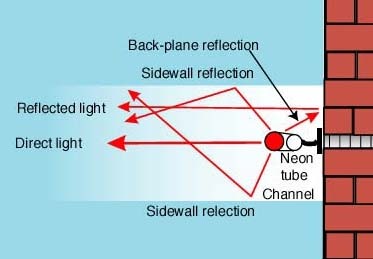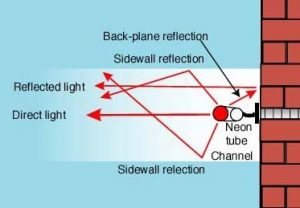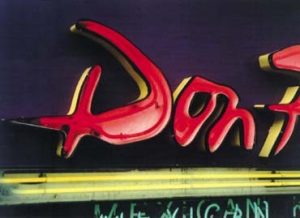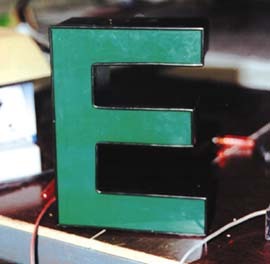In Europe, "neon sign" means "channel letters," and vice versa, in public vocabulary.
Though metallic sign letters predate neon tubes, gas discharges were used for signage long before the neon tube’s invention. Nevertheless, character-shaped neon tubing within a sheet-metal letter takes many different forms today. Here are some facts worth considering during a sign’s planning phase to avoid later trouble.
Channel-letter types
Sheet-metal letters are normally custom items, so each installation is unique. You can buy ready-made letters off the shelf from some U.S. companies, but most clients still prefer custom channel letters.
The classic channel letter, which provides a "channel" for the light to radiate in a certain direction, comprises a metal sidewall that screens one character stroke from the next. Thus, its open front exposes the mostly multi-stroke neon tube. Here, the direct color and impact of the neon glasswork determines the viewer’s impression of the sign.
Contrastingly, covered channel letters merely entail character-shaped metal boxes with translucent fronts and internal illumination. Covered channel letters are illuminated by different lightsources, but discharge tubing is still the most efficient and common method. The lightsource’s spectrum and distribution, and the face material’s transmission properties, play major roles in a covered letter’s color and light output. However, some materials block most of the light, which creates a colossal energy waste.
Reverse channel letters, which have recently become quite popular, comprise a metallic front, and the character is mounted a few inches from a background wall. Thus, light shines from inside the metal frame onto the back wall, creating a "halo" around each character. In the dark, you’ll see dark characters on an illuminated wall (Fig. 1).
Channel letters can be mounted two ways. When mounted flat on a back wall, electrical connections are pulled through the wall behind each character. Channel letters fastened to a support frame can be roof- or canopy-mounted, in which case, the hollow frame may serve as a raceway for high-voltage cabling.
Calculating light output
Local sign regulations may limit a sign’s light output. So, people frequently ask how to calculate a channel letter’s light output. In general, without knowing all material parameters and using very lengthy formulae, the calculation will vary roughly 200 to 300%. Thus, a simple calculation of 1,000-lumen light output could have true output ranging from approximately 250 to 3,000 lumens. The human eye’s subjective brightness scale is logarithmic, so a deviation of 200% can be noticed only in side-by-side comparisons.
But, you can easily glean a rough estimate of an open-face channel letter’s light output. You need the tube layout to determine each character’s exact visible tube length. Then, gather data from the glass supplier that outlines the tubing’s lumen-per-ft. output. But be careful, this data is normally standardized on 15mm glass, a 50mA operating current — typical within 60mA, U.S. transformers — and an average indoor temperature (for our purposes, 68



 Photo Gallery2 weeks ago
Photo Gallery2 weeks ago
 Ask Signs of the Times2 weeks ago
Ask Signs of the Times2 weeks ago
 Paula Fargo1 week ago
Paula Fargo1 week ago
 Real Deal6 days ago
Real Deal6 days ago
 Photo Gallery1 week ago
Photo Gallery1 week ago
 Women in Signs2 weeks ago
Women in Signs2 weeks ago
 Projects6 days ago
Projects6 days ago
 Women in Signs2 weeks ago
Women in Signs2 weeks ago












